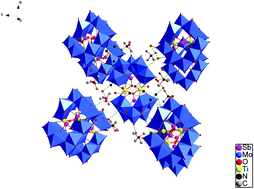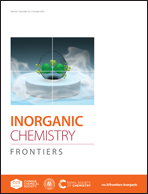Hydrogen bonding assisted formation of sandwich-type titanium-containing heteropolymolybdates: water-soluble and photoelectroactive†
Abstract
Titanium-substituted polyoxometalates related with the semiconductor TiO2 have potential applications in photocatalytic, photovoltaic and semiconducting materials. In this work, we synthesize two water-soluble titanium-containing polyoxomolybdates (NH4)8[(CH3)4N]2[Ti2(SbMo7O27)2]·15H2O (1) and (NH4)10[Ti2(AsMo7O27)2]·16H2O (2) by a conventional aqueous solution method. Ammonia water as a starting material could play dual roles of a pH adjustor and a hydrogen bond assistant, resulting in the formation of many strong hydrogen bonds in their crystal structures. The electrochemical properties of compounds 1 and 2 were investigated by cyclic voltammogram measurements, and the diffuse reflectance UV-vis spectra of 1 and 2 were recorded to calculate their semiconductor band gap (Eg) values. Furthermore, using the two compounds as semiconducting materials, we carried out the photoelectrochemical sensing of bisphenol A in aqueous solution, indicating that bisphenol A in aqueous solution could be detected by means of photocurrent change.



 Please wait while we load your content...
Please wait while we load your content...